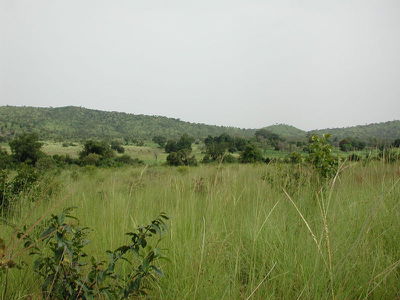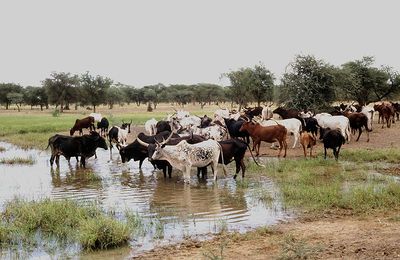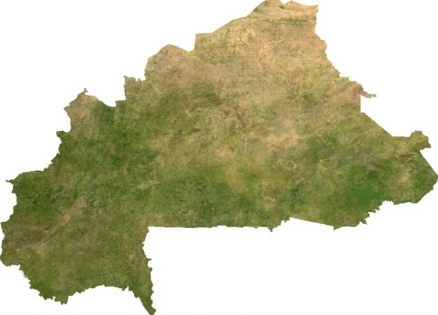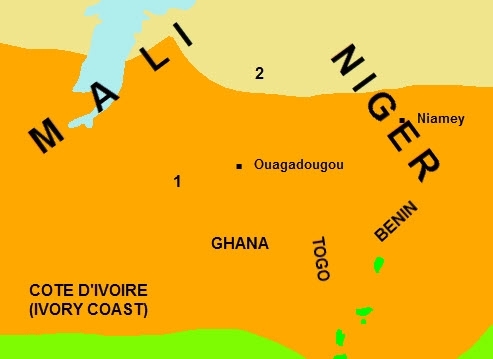Ecoregions of Burkina Faso
Ecoregions of Countries Collection 
Except for the northern most portion of the country, Burkina Faco is covered by West Sudanian savanna [1]. and the Sahelian Acacia Savanna [2] to the north.
West Sudanian savanna
 Savanna in southwest Burkina Faso, near Gbomblora on the road from Gaoua to Batié. Source: Stefan Dressler/Wikimedia Commons The West Sudanian Savanna is a hot, dry, wooded savanna composed mainly of large tree species and long "elephant" grass.
Savanna in southwest Burkina Faso, near Gbomblora on the road from Gaoua to Batié. Source: Stefan Dressler/Wikimedia Commons The West Sudanian Savanna is a hot, dry, wooded savanna composed mainly of large tree species and long "elephant" grass.
The habitat has been greatly reduced, degraded, and fragmented by agricultural activities, fire, and clearance for wood and charcoal, while populations of most of the larger mammal species have been decimated by over-hunting. Although many protected areas exist, most are under-resourced "paper parks" with little active enforcement on the ground.
The hot climate and poor infrastructure have resulted in little development of tourism in the region.
There has been significant loss and fragmentation of the original wooded savanna habitat, especially in areas of high human population density such as Nigeria. The remaining blocks of habitat are found mainly in protected areas, which have been established in most of the countries of the ecoregion.
The total area of protected lands is over 90,000 km2. This is a relatively large area, but only represents 6.7% of this huge ecoregion. There are also damaging activities occurring in many of these protected sites, which are resulting in further declines in large animal populations. Protected areas in this ecoregion include the transboundary ‘W’ National Parks in Niger, Burkina Faso, and Benin.
The habitats of the ecoregion are principally threatened by the agricultural and herding activities of the local populations. There are considerable pressures on the land from seasonal farming, grazing animals, cutting trees and bushes for wood, burning woody material for charcoal, and from wild fires. All of these pressures have reduced and degraded natural habitats. Climatic desiccation is a further threat, exacerbating human pressures, as the ability of the ecosystem to recover from overuse is reduced when there is little rainfall.
Sahelian Acacia Savanna
 Sahelian Acacia savanna, cattle at Mare de Kissi, Oudalan, Burkina Faso. Source: Marco Schmidt The Sahelian Acacia Savanna stretches across Africa from northern Senegal and Mauritania on the Atlantic coast to Sudan on the Red Sea, varying in width from several hundred to over a thousand kilometers (km). The word "sahel" means "shore" in Arabic and refers to the transition zone between the wooded savannas of the south and the true Sahara Desert. The ecoregion thus lies south of the Southern Saharan steppe and woodland Ecoregion and north of the West and East Sudanian savanna Ecoregions.
Sahelian Acacia savanna, cattle at Mare de Kissi, Oudalan, Burkina Faso. Source: Marco Schmidt The Sahelian Acacia Savanna stretches across Africa from northern Senegal and Mauritania on the Atlantic coast to Sudan on the Red Sea, varying in width from several hundred to over a thousand kilometers (km). The word "sahel" means "shore" in Arabic and refers to the transition zone between the wooded savannas of the south and the true Sahara Desert. The ecoregion thus lies south of the Southern Saharan steppe and woodland Ecoregion and north of the West and East Sudanian savanna Ecoregions.
The original Acacia bushland of this ecoregion has been greatly altered over thousands of years, through long-term climatic changes and also through anthropogenic effects. In the past there were substantial populations of large mammalian herbivores, which would have grazed and browsed the vegetation. The remaining blocks of intact habitat are found mainly in the protected areas. In other areas the habitat is often degraded, but extensive and relatively continuous in sparsely populated areas.
The total area of protected land is around 224,825 km2. This is a large total area, but because the ecoregion is so vast, the actual percentage protected is quite low (approximately 5 percent). Parks found in this area include the Sahel Partial Faunal Reserve in Burkina Faso.
Context
Ecoregions are areas that:
[1] share a large majority of their species and ecological dynamics;
[2] share similar environmental conditions; and,
[3] interact ecologically in ways that are critical for their long-term persistence.
Scientists at the World Wildlife Fund (WWF), have established a classification system that divides the world in 867 terrestrial ecoregions, 426 freshwater ecoregions and 229 marine ecoregions that reflect the distribution of a broad range of fauna and flora across the entire planet.

